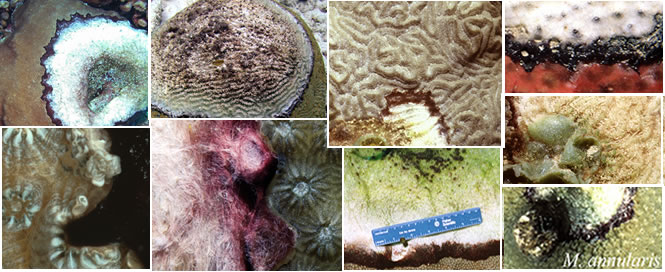 Official websites use .gov
A .gov website belongs to an official government organization in the United States. Official websites use .gov
A .gov website belongs to an official government organization in the United States. |
 Secure .gov websites use HTTPS
A lock or https:// means you’ve safely connected to the .gov website. Share sensitive information only on official, secure websites. Secure .gov websites use HTTPS
A lock or https:// means you’ve safely connected to the .gov website. Share sensitive information only on official, secure websites. |
Solutions today for reefs tomorrow
Home » Coral Disease » Characterized Diseases » Pigmented Band Diseases

Black Band Disease, BBD (A-I)
Black or dark reddish-brown band or mat of filamentous organisms (A), peppered with white filaments (B), 1-30 mm wide, radiating out 1-20 mm/day (C-D). The band may be linear to annular (E-F) to irregular. It initiates at the colony margin or base (C) or a focal site of injury sue and stark white tissuedepleted skeleton. Secondary colonization of denuded skeleton by filamentous algae followed by other epibionts (H). Affects 22 scleractinian corals, 1hydrozoan coral and four octocorals.(G); in brain corals often starts at the top and spreads down (H). The band separates healthy tis

Red Band Disease, RBD (K-O)
Thin red band of filamentous cyanobacteria loosely associated with the coral, separating tissue and white skeleton; filaments are less mat-like and do not contain white filaments (N) . A second variety consists of a mat that expands in day over tissue and skeleton and forms a discrete band at lesion margin at night (O).
Similar conditions: BBD and RBD may be difficult to distinguish; cyanobacteria may also form a mat on the surface of corals that migrates diurnally and can kill tissue; Mostly on Colpophyllia, Agaricia, Meandrina.

Caribbean Ciliate Infection, CCI (P-T)
A diffuse black or grey band, several mm up to 1-2 cm thick, with a “salt-and-pepper” speckled appearance, separating living tissue from algal colonized skeleton. May form a discrete, dark band several mm thick (acute infection) or diffuse, scattered patches on algal colonized skeleton. Ciliates visible with hand lens. May occur on colonies with white plague or WBD. Affects Montastraea, Acropora (Q-S), Diploria (T), Dichocoenia, Agaricia (22 species).
Similar conditions: CCI can be confused with BBD, DSD, and denuded skeleton colonized by epibionts.
The CDHC is a network of scientists, managers, and agency representatives devoted to understanding coral health and disease.
Funding support provided by NOAA CRCP
Web hosting by NOAA NCCOS
Coral Disease and Health Consortium
Hollings Marine Laboratory
331 Fort Johnson Road
Charleston, SC 29412 USA
Email: cdhc.coral@noaa.gov